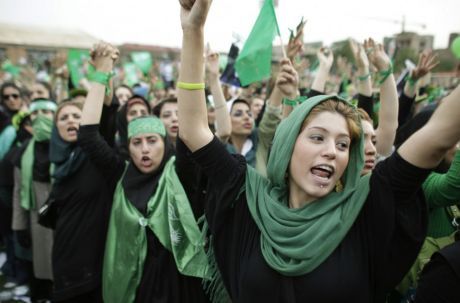Features
You are here
Iran 2009

June 25, 2012
In the 1970s, under the brutal Shah of Iran, Iran was one of the chief allies of the U.S. The Shah was overthrown by revolution in 1979, but hopes for change were dashed when social forces, represented by the Ayatollah Khomeini, hijacked the revolution. There was a brutal crackdown on the left and the social movements.
In 2009, however, we caught a glimpse of the ferment that has been developing beneath the surface of Iranian society, a ferment that exploded in a massive pro-democracy movement, anticipating the great Middle East democracy movements of 2011, and giving notice that developing inside Iranian society are the forces which can rekindle the hopes of 1979.
June 12, 2009, was election day, and it was widely expected that the results would indicate trouble for President Ahmadinejad. In office since 2005, he had presided over a militarization of Iranian society, embedding the dreaded Iranian Revolutionary Guard Corps (IGRC) throughout the national state, and in all 30 provinces. The IGRC is part of a network of repressive apparatuses in Iran, which are important both politically and economically. The IGRC, by 2009 had acquired “a vast economic empire, from oil and construction to cellphone technology”, according to one observer.
The campaign against Ahmadinejad coalesced around Mir-Hossein Moussavi. Deeply embedded in the elite which ran Iran in the 1980s, he had been involved in disputes and splits in that elite, but never as a “revolutionary”. In 1997, he emerged as a key adviser to then president Khatami, a presidency that sought a tentative “modernizing” of the Iranian revolution.
Ahmadinejad’s 2005 presidency represented a conservative reaction against this “modernizing” trend.
But behind the scenes, Iran was in fact modernizing. The chart on this page, showing the ups and downs of Gross Domestic Product (GDP) per capita, gives an outline of this process.
The 1979 revolution took place in the context of very steep economic crisis. Recovery from that crisis became impossible in the 1980s, after Iraq—egged on by the US—launched a terrible war against Iran. One million died, countless were maimed, and the economy went into a tailspin.
But with the war finally over, in the 1990s, Iran’s economy began to steadily grow. By 2006, GDP per capita had been growing very fast for a decade, and was finally significantly greater than before the revolution. The country’s principal city, Tehran, had emerged as a massive urban centre of some 8 million people. The millions of young people in the new urban centres felt little affinity with the conservative clerics who were the ideological backers of the president. When growth came to a halt in 2007, and the economy began to stagnate and slowly decline, a new movement erupted.
That movement was not visible in the 2008 parliamentary elections, which proceeded in the familiar dull pattern of previous years. But 2009 was completely different.
Moussavi, in a June 3 televised debate, called Ahmadinejad a liar and a dictator. This was unprecedented. The next day, thousands took to the streets chanting “death to the liar”.
Green Movement
The crowds wore green. A young man named Mostafa Hassani had come up with the idea that those who wanted change should use green—on ribbons, armbands, headbands, scarves—and the sign of the breadth of the movement was the spread of the colour throughout the country.
The election campaign in Tehran was electric. Into the wee hours tens of thousands campaigned in a citywide free-for-all. Every morning Tehran was abuzz with the latest election news. Men crowded around newsstands to read the headlines and to discuss the previous night’s candidate debate. Just inside the main gate to Tehran University, two days before the election, a middle-aged guard who had lost a leg in the war with Iraq in the 1980s marveled at the thousands of students marching past, flying green banners in support of Moussavi’s reformist movement. “Enghelab!” he said, nodding. ‘It’s a revolution!’”
Tens of millions of votes were cast (Iran is a large country with some 73 million people). But miraculously, those tens of millions of votes were “counted” in just two hours. Ahmadinejad was declared the victor, ostensibly winning two-thirds of the votes from a record turnout.
In protest, hundreds of thousands of people took to the streets. The IGRC was already there. While people were still voting, trucks full of IGRC troops had taken up strategic positions in the major cities. Officially, 37 people were killed in the crackdown that followed. The real figure is likely twice as high. In the first wave of arrests, 2,000 went to jail. By August, that figure had grown to 4,000. The movement continued into the winter, but the pressure of the regime was unrelenting. The 2009 movement was not able to sustain itself.
Like all movements at their beginning, the one in 2009 was a confusing mixture. At the top were old conservatives like Moussavi, reminted as a reformist. Behind the scenes were sections of big capital, who were (and are) seeking an end to the sanctions which are making economic life in the country so difficult. But on the streets were ordinary students and workers, who jumped into the breach created by a split at the top of society, to demonstrate for an end to repression, and for meaningful reforms in the way in which politics and economics are structured in their country.
The response of those outside Iran was, in many cases, not helpful. There were many who dismissed the Green Movement as a tool of the U.S. But there is no future with a left that uncritically backs repressive figures like Ahmadinejad.
Real solidarity needs to operate on two fronts: against threats from the US and Israel to bomb Iran, and in solidarity with the social movements which are taking shape, in very difficult circumstances, to fight for democracy.
Section:
- Log in to post comments










